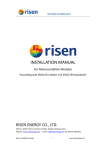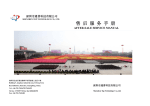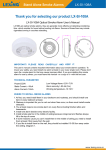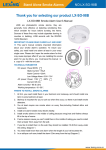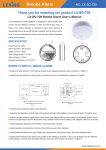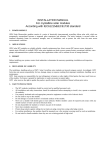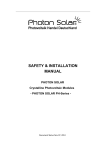Download INSTALLATION MANUAL
Transcript
INSTALLATION MANUAL For Monocrystalline Modules “According with IEC61215 edition 2 & IEC61730 standards” RISEN ENERGY CO., LTD. Address: Meilin Tashan Ind.Zone, Ninghai, Ningbo, Zhejiang, China Website: www.risenenergy.com Email: [email protected] Tel: 86‐574‐59953071 Risen Installation Manual 1 www.risenenergy.com Overview Thank you very much for using Risen Energy PV modules. In order to enable the PV modules to be installed correctly and to generate electric power properly, please read the following operation instructions carefully before installing and using the modules. Please remember that you are operating a product that generates electricity, and therefore certain safety measures need to be implemented in order to avoid accidents. 1. Instruction Risen Energy Company Limited (Risen Energy) has a long history of successful innovation within the solar industry. The company was fund in 1986 and began researching photovoltaic modules in 1999. The company has several fully integrated product lines, including wafers, cells, Mono and Polycrystalline Silicon modules (MODULES). Risen Energy products are exported to overseas markets. With an experienced international management team and a strong reputation for innovation, Risen Energy supplies the highest quality MODULES in a range of sizes designed to meet the requirements of the most demanding energy and power users worldwide. 2. Power MODULES Risen Energy MODULES consist of a series of electrically interconnected crystalline silicon solar cells, which are permanently encapsulated between a tempered glass cover, an EVA potted with TPT back sheet. The entire laminate is secured within an anodized aluminum frame for structural strength; ease of installation, and to protect the cells from the most severe environmental conditions. The MODULES which are listed below table applicable for this Manual, the data are tested at STC. The MODULES power tolerance is +/-3% Application Max Isc Voc (A) (V) 36.2 5.5 45.0 74.7 A 1000V 5.19 36.6 5.57 45.1 75.6 A 1000V 195 5.3 36.8 5.6 45.3 76.8 A 1000V SYP200S-M 200 5.4 37.0 5.72 45.4 77.0 A 1000V SYP220S-M 220 4.58 48.0 4.82 59.5 76.6 A 1000V SYP230S-M 230 4.77 48.2 5.06 59.8 76.0 A 1000V SYP240S-M 240 4.95 48.4 5.26 60 76.0 A 1000V SYP250S-M 250 5.15 48.6 5.45 60.3 76.2 A 1000V SYP260S-M 260 5.33 48.8 5.66 60.5 76.0 A 1000V Pmpp Impp (W) (A) SYP185S-M 185 5.11 SYP190S-M 190 SYP195S-M Modules Vmpp(V) FF% class voltage maximum over current Recommended parallel protection ratings maximum series configuration class SYP185S-M 10A 22 2 Class C SYP190S-M 10A 22 2 Class C Modules Risen Installation Manual 2 module system Fire resistance www.risenenergy.com SYP195S-M 10A 22 2 Class C SYP200S-M 10A 22 2 Class C SYP220S-M 10A 16 2 Class C SYP230S-M 10A 16 2 Class C SYP240S-M 10A 16 2 Class C SYP250S-M 10A 16 2 Class C SYP260S-M 10A 16 2 Class C Table 1: Parameters of the Risen Energy MODULES Under normal conditions, a photovoltaic module is likely to experience conditions that produce more current and/or voltage than reported at STC. Accordingly, the values of Isc and Voc marked on this module should be multiplied by a factor of 1.25 when determining component voltage ratings, conductor current ratings, fuse sizes, and size of controls connected to the PV output. 3. Applications Risen Energy MODULES are a highly reliable, virtually maintenance free power supply, designed to operate efficiently in sunlight, these solar modules are ideal for charging storage batteries used to power remote homes, recreational vehicles, boats, telecommunications systems and other electric generation application. 4. Climate Condition Install the RISEN ENERGY Crystalline series MODULES in the following conditions: ● Ambient temperature: -40℃ to +40℃ ● Operating temperature: -40℃ to +85℃ ● Operating Storage temperature: -20℃ to +40℃ ● Humidity: below 85RH% ● Mechanical Load Pressure: below 112.78lb/ft2 (5400Pa)*. *Note: the mechanical load bearing (including wind and snow loads) of the MODULES is based on the mounting methods. The professional system installer must be responsible for mechanical load calculation according to the system design. 5. Mounting Site Selection The MODULES should be mounted in a location where they will receive maximum sunlight through the year and also to be mounted over a fire resistant roof covering rated for the application. In the Northern Hemisphere, the MODULES should face south, and in the Southern Hemisphere, the MODULES should face north. MODULES facing 30degrees away from true South (or north) will lose approximately 10 to 15 percent of their power output. If the MODULES face 60 degrees away from true South (or North), the power loss will be 20 to 30 percent. When choosing a site, avoid trees, buildings or obstructions which could cast shadows on the solar modules especially during the winter months when the arc of the sun is lowest over the horizon. Shading causes loss of output, even though the factory fitted bypass diodes of the MODULES will minimize any Risen Installation Manual 3 www.risenenergy.com such loss. Do not install the MODULES close to naked flame or flammable materials. Do not install the MODULES in a location where it would be immersed in water or continually exposed to water from a sprinkler or fountain etc. Do not install the MODULES in a marine environment and/or area where salty wind hit directly. Do not install the MODULES in corrosive environment, such as corrosive salt area or sulfurous area, etc. Do not install the MODULE to substitute, even partially a roof or wall of a habitable structure. 6. MODULE Tilt Angle RISEN ENERGY MODULES connected in series should be installed at same orientation and angle. Different orientation or angle may cause loss of output power due to difference of amount of sunlight exposed to the MODULES. RISEN ENERGY MODULES produce the most power when they are pointed directly at the sun. For installations where the MODULES are attached to a permanent structure, the MODULES should be tilted for optimum winter performance. As a rule, if the system power production is adequate in winter, it will be satisfactory during the rest of the year. The MODULESE tilt angle is measured between the solar MODULES and the ground (Figure 1). Optimal tilting of MODULES is almost the same as the latitude of installation location. Figure 1 MODULES Tilt Angle 7. Mounting the MODULE The frame of each MODULE has eight 9mm diameter mounting holes (Figure 2 and Figure 3). These are used to secure the MODULES to the support structure. For installation safety, we recommend that minimum torque of screw between 5-8Newton-meters. The mounting method is as Figure 4 below. The four holes close to the corners of the MODULE are most often used for mounting. Clearance between the MODULES frame and the mounting surface may be required to prevent the junction box from touching the surface, and to circulate cooling air around the back of the MODULE. In case the MODULES will be mounted on the roof or wall of a building, the standoff method or the rack method are recommended. Standoff: The MODULES are supported parallel to the surface of the building wall or roof. Clearance between the MOUDLES frames and surface of the wall or roof is required to prevent wiring damage and Risen Installation Manual 4 www.risenenergy.com to allow air to circulate behind the MODULE. The recommended standoff height is Class Ratings. Rack: The supporting frame is used to mount modules at correct tilt angle. The MODULES are not designed for integral mounting as part of a roof or wall. The mounting design may have an impact on the fire resistance. Figure 2: Aluminum frame: 1580X1070X50X35(mm) Risen Installation Manual 5 www.risenenergy.com Figure 3: Aluminum frame: 1580X808X50X35(mm) Figure 4: Mounting Method Risen Installation Manual 6 www.risenenergy.com 8. Wiring For MODULES wiring, when your PV system system open circuit voltage. Check your local includes other components (batteries, charge codes for requirements. controllers, inverters, etc.), be sure to follow the safety recommendations of their manufacturers. These MODULES contain factory installed bypass diodes. If these MODUES are incorrectly connected to each other, the by-pass diodes or cable or junction box may be damaged. For array wiring, the terms “array” is used to describe the assembly of several MODULES on a support structure with associated wiring. Use copper wire that is sunlight resistant and is insulated to withstand the maximum possible 9. Grounding For grounding, there is a grounding label and two holes at the panel, of whose position refer to the Figure 1. Size and earth the equipment grounding conductor in accordance with local requirements or the IEC. Attach the equipment grounding conductor to the module frame using the hole and hardware provided. Note that a stainless steel washer is used between the ground wire and the module frame (see Figure 5). The diameter of hole on module is 4mm. The diameter of nut is 5mm. According to GB/T 97.1, d1 is 5.3mm, d2 is 10mm, h is 1mm. These washers are used to avoid corrosion due to dissimilar metals. Tighten the screw that the minimum of torque screw between 0.5 and 1.0 Newton meters. We recommend you attach all module frames to an earth ground. Attach a separate ground wire to one of the extra mounting holes on the module frame with a self-tapping screw. The racks must also be grounded unless they are mechanically connected by nuts and bolts to the grounded modules. Grounding is achieved by securing the array frame for both roof and field mounted applications. Please note all washers and nuts are stainless steel. Figure 5: Grounding method Risen Installation Manual 7 www.risenenergy.com 10. Junction Box Modules Junction Connector Box Type type Connector temperatu re ratings Wire size and type Cable ambient temperature Bypass diodes type 40 to 90℃ 10SQ050 40 to 90℃ 10SQ050 40 to 90℃ 10SQ050 40 to 90℃ 10SQ050 40 to 90℃ 10SQ050 40 to 90℃ 10SQ050 40 to 90℃ 10SQ050 40 to 90℃ 10SQ050 40 to 90℃ 10SQ050 2PfG 1169 SYP185S-M PV-ZH008 PV-ZH202 -40 to 85℃ 1*4.0mm 2*900MM 2PfG 1169 SYP190S-M PV-ZH008 PV-ZH202 -40 to 85℃ 1*4.0mm 2*900MM 2PfG 1169 SYP195S-M PV-ZH008 PV-ZH202 -40 to 85℃ 1*4.0mm 2*900MM 2PfG 1169 SYP200S-M PV-ZH008 PV-ZH202 -40 to 85℃ 1*4.0mm 2*900MM 2PfG 1169 SYP220S-M PV-ZH008 PV-ZH202 -40 to 85℃ 1*4.0mm 2*900MM 2PfG 1169 SYP230S-M PV-ZH008 PV-ZH202 -40 to 85℃ 1*4.0mm 2*900MM 2PfG 1169 SYP240S-M PV-ZH008 PV-ZH202 -40 to 85℃ 1*4.0mm 2*900MM 2PfG 1169 SYP250S-M PV-ZH008 PV-ZH202 -40 to 85℃ 1*4.0mm 2*900MM 2PfG 1169 SYP260S-M PV-ZH008 PV-ZH202 -40 to 85℃ 1*4.0mm 2*900MM Partial shading of an individual MODULE can cause a reverse voltage across the shaded MODULE. Risen Installation Manual 8 www.risenenergy.com Current is then forced to go through the shaded area by the other MODULE. By having a bypass diode, the forced current will bypass the shaded module in a series circuit, thereby minimizing module heating and array current losses. For 12-volt systems and higher: Each solar module junction box has a diagram illustrating the proper direction for the by- pass diode to be installed between two of the terminal screws. When the solar MODULES are connected as individual series strings first, and then these strings are connected in parallel, bypass diodes should be used in each junction box, this is the simplest wiring arrangement for most installations. At a minimum the bypass diodes must have the following electrical characteristics: • Rated Average Forward Current above maximum system current at the highest MODULES operating temperature. • Rated Repetitive Peak Reverse Voltage above maximum system voltage at the lowest MODULE operating temperature. 11. Preparation before Installation Unpacking Once the PV MODULES have been shipped to the installation site all of the parts should be unpacked properly with care. Caution: The environment for unpacking the MODULES and all other apparatus should be proofed against dampness and rainfall. a) Visual check before installation, to make sure there is no bug in the packing and junction b) Check the serial number. c) Check the PV MODULES with irradiance of more than 600W/㎡ and get the voltage. In case the voltage is ZERO, it should not be installed and please contact the supplier. d) All the washers, nut, and bolt must be stainless steel. 12. Safety Precautions a) Make sure the MODULES are arranged so that the current and voltage characteristics of the array are within the tolerance of the device to which the array will connect. MODULES sold in Europe rate up to 1000V DC. b) For rooftop installations, this MODULE has Class C Fire Rating and must be installed over a roof of appropriate fire resistance. Consult your local building department to determine approved roofing materials. c) The shock hazard increases as modules are connected in parallel producing higher current. The shock hazard increases as modules are connected in series producing higher voltages. To avoid the hazard of electric shock, work only under dry conditions, with dry module and tools. 13. Warnings MODULES are live electrical power source when exposed to light. Array of many MODULES can cause lethal shock and burn hazards. Although single module produces only a low voltage and current, shocks and burns are still a potential hazard. MODULES should be covered with an opaque material during installation to avoid shocks or burns. Do not touch the live parts of cables and connectors. Using appropriate safety equipment (insulated tools, insulating gloves, etc) when handling MODULES. Risen Installation Manual 9 www.risenenergy.com 14. Permit Before installing your system, contact local authorities to determine the necessary permitting, installation and inspection requirements. 15. Installation and Operation • Systems should be installed by qualified professionals only. The process involves electricity and can be dangerous if the installing personnel are not familiar with the appropriate safety procedures. • Do not step on the module. • Artificially Sunlight shall not be concentrated on the module. • Although the modules are quite rugged, the glass can be broken (and the module will no longer work properly) if it is dropped or hit by tools or other objects. • Solar modules have a protective front glass. Broken solar module glass is an electrical safety hazard (electric shock and fire). These modules cannot be repaired and should be replaced immediately. d) Do not damage the back sheet of a MODULE, to avoid the hazard of electric shocks and fire. Children and unauthorized persons should not be allowed close to the installation of the PV MODULES. e) Do not remove any part installed by Risen Energy or disassemble the MODULES. f) Protect plug against soiling, do not make any plug connections using soiled plug contacts. g) MODULES must be carried more than two persons by the frame and wear non-slip gloves. h) Do not use MODULES of different configurations in the same systems. i) Do not drill additional mounting holes in the MODULES frames, as it will void the warranty. j) All instructions should be read and understood before attempting to install, wire, operate and maintain the MODULE. 16. Battery When solar modules are used to charge batteries, follow the battery manufacture’s recommendations if batteries are used with MODULES. The battery must be installed in a manner which will protect the performance of the system and the safety of its users. The battery should be away from the main flow of people and animal traffic. Select a battery site that is protected from sunlight, rain, snow, debris, and is well ventilated. Most batteries generate hydrogen gas when charging, which is explosive. Do not light matches or create sparks near the battery bank. When a battery is installed outdoors, it should be placed in an insulated and ventilated battery case specifically designed for the purpose. 17. Inspection • Follow the requirements of applicable National and local electrical safety Codes. 18. Maintenance Solar modules require very little maintenance. It is not un-common for a remote site to be checked but once per year. Under most conditions, normal rainfall is sufficient to keep MODULE glass clean. If dirt build-up becomes excessive, clean the glass with a soft cloth using mild detergent and water. Do not clean the MODULES with cold water during the warmer hours of the day in order to avoid creating any thermal shock that maybe damage the MODULE. Modules that are mounted flat should be cleaned more often, as they will not "self clean" as effective as modules mounted at 15 degree or greater angle. Once a Risen Installation Manual 10 www.risenenergy.com year, check the tightness of terminal screws and the general condition of the wiring. Also, check to be sure that mounting hardware is tight. Loose connections will result in damage for MODULES or array. Changed MODULES must be same type. Cover the front surface of MODULES by an opaque or other material when repairing. When MODULES exposed to sunlight, it generate high voltage and are dangerous. Warnings: For any electrical maintenance,the PV system must first be shut down. Improper maintenance can cause lethal electric shock and/burns. 19. Disclaimer of Liability The installation, handling and use of Risen Energy Crystalline series modules are beyond company control. Accordingly, Risen Energy does not assume responsibility for loss, damage, injury or expense resulting from improper installation, handling, use or maintenance. Risen Energy assumes no responsibility for any infringement of patens or other rights of third parties that may result from use of the modules. No license is granted by implication or under any patent or patent rights. Risen Energy reserves the right to update the product, specifications or this installation Manual without prior notice. Risen Energy Co., Ltd. Add: Ninghai Meilin Tashan Industrial Zone, Ningbo, Zhejiang, China Tel: 0086-574 59953071 Fax: 0086-574 65173107 Email: [email protected] Website: www.risenenergy.com Risen Installation Manual 11 www.risenenergy.com











